#wwii romania
Text
The Blood Years review

4.5 stars/5 stars
Recommended if you like: historical fiction, WWII, non-German/Britain/US WWII, Jewish characters, younger teen MC
Big thanks to Netgalley, Balzar + Bray, and the author for an ARC in exchange for an honest review!
TW: Holocaust, rape
I always enjoy reading historical fiction books set outside the traditional countries we see historical fiction set in (i.e., USA, Britain, France, Germany...maybe Russia, but not many of those). This book is set in Romania and starts slightly before their occupation and ends almost immediately after liberation ('liberation'). It was interesting to get a different view of that era of history, especially since Romania had to deal with both Soviet and German occupation.
It was interesting to read about the recent history of Romania leading up to WWII since it isn't really a country I know too much about. The parts about the Soviet and German occupation were also interesting, but at least I know what to expect from that (and I also actually read a nonfiction book about Romania in WWII in 2022 or '21). Both occupations are horrifying in their own ways and have slightly different threats and rules. The juxtaposition between the two worked well to highlight both the similarities and the differences between the Soviets and Germans.
Frederieke, Rieke, starts the story around age 12/13 (except for the prologue, where she's 6), when things are tense in Europe but still relatively calm in Romania. At the time, her life largely revolves around school, ballet, her sister, and Opa. Over the course of the story Rieke has multiple points where the world shifts under her feet, both in small ways, like her father leaving, and in big ways, like occupation. Each time her world shifts, Rieke must reorient and make a decision about how she is going to move forward. This next part is slightly spoilery, but I'm not putting a spoiler warning since it relates to one of the TWs: There is a part toward the end where Rieke is raped by an older man, though the scene isn't particularly graphic, and it's mentioned as happening several more times before Rieke is hospitalized for an unrelated illness. It is also heavily implied that Astra was raped during Soviet occupation.
Opa, Rieke and Astra's grandfather, has already lived through one world war and isn't looking forward to a second one. He tries to protect the girls and his family as long as he can, but the hate of others isn't so easy to hide, and their hardships only become worse when the Germans take over the country. Despite everything going on, Opa continues to put his family first and continues to strive to uphold the morals he holds close.
Astra is a hard character to fully like. At the beginning of the book, she's relatively okay, but the more Rieke remembers her younger childhood and the more we see Astra falling in love, it's clear she's not a very nice person to her sister. Since Rieke is the narrating character, that makes it kind of hard to like Astra even if Rieke loves her older sister dearly. That being said, Astra becomes much better toward the middle/later parts of the book, though she still has her moments (and I'm not super thrilled that she allowed what was going on with Rieke toward the end). I will say though, by the end of the book it's very, very clear that Astra loves Rieke dearly, even if it isn't always expressed.
Marcel does fit with Astra, though he's largely flighty only with her. Rieke doesn't like him at first, and so I didn't like him at first either, but he really does come through for the family he becomes a part of. I won't comment on his romantic flightiness, but he definitely isn't a bad person.
I think the author did a good job capturing the wider picture of what was going on in Romania while also keeping the focus on Rieke and her family. She also does a good job of shifting between the two, with Rieke being able to note the larger changes occurring around her by noticing the ones that impact her and the daily lives of those around her. The historical part of the book was done very, very well in my opinion.
Overall, this was a good book. Obviously I am not a fan of the second TW, and on the one hand I'm glad it was kind of brushed over but on the other hand I do feel like more attention should've been called to what was happening. Unrelated to that, I liked that Astra, Rieke, and their friends were dancers. There really aren't enough books where people are just casually ballet dancers.
#book#bookshelf#bookworm#books#bookaddict#bookaholic#booksarelife#bookstagram#booklr#bookblr#historical fiction#ya historical fiction#wwii#wwii romania#jewish characters#jewish heritage month#holocaust#tw shoah#tw rape#netgalley#netgalley review#netgalley read
0 notes
Text

US B-24 Liberators unload their deadly cargo as they press home the attack on German oil refineries and storage facilities during Operation Tidal Wave - Ploesti, Romania, 1st Aug 1943
#world war two#1940s#worldwar2photos#history#ww2 history#ww2#wwii#world war 2#ww2history#wwii era#b 24 liberator#b24#1943#romania#ploesti#USAAF#us air force
190 notes
·
View notes
Text
On This Day In History
August 23rd, 1944: Romania switches sides from the Axis to the Allies in World War II.
71 notes
·
View notes
Text
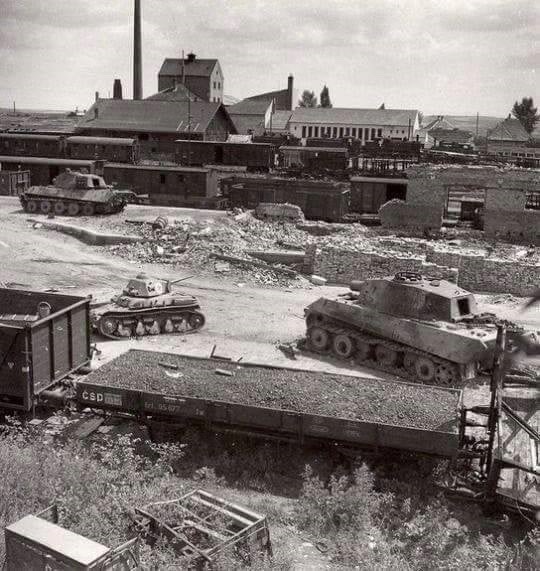
An abandoned French-made, Romanian-operated R35 between two destroyed Tiger IIs in Budapest. 1945
#siege of Budapest#Soviet occupation of Romania#wwii#eastern front#r35#Tiger II#tanks#French armor#French tanks#German tanks#German armor
20 notes
·
View notes
Text

Des artilleurs allemands au canon antichar PaK 40 de 75 mm – Front roumain – Front de l'Est – Frontière soviéto-roumaine – Printemps 1944
Photographe : Heuberger
©Bundesarchiv - Bild 101I-024-3543-09
#WWII#front de l'est#eastern front#front roumain#romanian front#armée allemande#wehrmacht#heer#canon antichar#anti-tank gun#Pak 40#roumanie#romania#union soviétique#soviet union#1944
5 notes
·
View notes
Text
Like I know she's evil and perhaps one of history's most famous villains. But this Lady Macbeth is definitely a milf
2 notes
·
View notes
Link
They're green and they're mean
#Romania#Axis#Nazi#fascism#Iron Guard#Legionnaires#pogroms#ethnic cleansing#anti-semitism#holocaust#crimes against humanity#genocide#history#WWII
0 notes
Text

Jewish family from Sighet, Maramures, Romania, around 1920
Sighet was once one of the most Jewish of all places in Europe. Before WWII more than a third of the city was Jewish, and many Jews worked the land as peasant farmers in the surrounding countryside. The culture of Maramures, and of Sighet in particular, resonates with the influence of Yiddish in the local dialect, the local food, and the music.
347 notes
·
View notes
Text

THIS.
This guy from Romania put everything down splendidly.
I understand, most "woke" US teens want to push "US bad" narrative nowadays to look cool, but for those of you guys who feel depressed - because your media has been constantly telling you about America's many failures in foreign politics in the last 50 years as if it was all a failure.... But guys. Guys. My guys. Americans.
YOU LITERALLY FREED A DOZEN EUROPEAN COUNTRIES.
FREED. Do you understand me?
People here in Eastern Europe CELEBRATED it like they celebrated the end of WWII. People CRIED and hugged and went to the streets when the fucking empire fell.
People created human chains that SPANNED COUNTRIES to tell the world they do not want to be part of USSR (Google "The Baltic Way").
In Ukraine, the all-country vote for leaving USSR got the overwhelming ~90% in favor support throughout all the country (YES, IN RUSSIAN-SPEAKING DONBAS TOO)
The propaganda (fed by Russian spies in the West) has warped your own impression of yourselves, so I am putting it all in perspective so you would know - you did some incredible good too, guys. You helped a dozen of previously military occupied countries free themselves.
And now you are helping the same countries protect their Independence when the same regime that had occupied them previously have now recovered its strength and have started trying to re-collect them all again.
#america#ukraine#eastern europe#baltic states#ussr#soviet union#russian imperialism#russian culture#russian invasion#russia is a terrorist state#україна#укртумбочка#укртамблер#укртумба
119 notes
·
View notes
Text
The fact Val probably changed his accent because of the Cold War
Following/during the later stages of WWII, tensions between the US (and thereby Western Europe/NATO) and the USSR (Eastern Europe/Warsaw Pact) became so high that proxy wars and nuclear power were at every corner.
At that point in the world, Val wouldn’t be able to keep his accent. Val’s whole deal is getting people to LIKE HIM. He will DIE if people don’t like him. If he opens his mouth in 1950s United States and spews a “Soviet/communist accent” (Romania was part of the Soviet Bloc but was not an SSR), do you think people would like him? No
He had to change his accent to stay alive in America
(This also means it’s very recent; to him 70 years is the equivalent of last month. Which explains why he falters so much)
#monster high#kieran valentine#spelldon cauldronello#draculaura#spelldon x valentine#valentine x spelldon
84 notes
·
View notes
Text
It's not really in the spirit of the lighthearted romance genre, but every so often I want to write a story in the Shivadhverse that's about one of the kings passing on to the next king the weird covert stuff you occasionally just have to do as a working politician. Canonically, though I haven't put it in the books anywhere, Fons-Askaz was a neutral ground where Meetings That Never Happened could take place during the cold war, but I also step very carefully around that kind of thing because "A Jewish politician secretly mediating a peace treaty" can spill over into "Secretly Jews run the world" very, very quickly.
But I was listening to a podcast about Nicolae Ceaușescu this morning and it was talking about how basically, he ransomed Romania's Jewish population for spending cash -- if Romanian Jews wanted to immigrate out of the country there was a visa fee, which Ceaușescu then took and used on shopping sprees outside of Romania, a cash-low socialist country at the time. There is a reason the podcast about him is called Behind The Bastards.
Most of the Jews leaving Romania were heading to Israel, which paid the fees to get them out. Still, I can't shake the idea of Jason introducing Michaelis to the more dangerous side of the job by taking him, around age 15 or 16, to a nighttime meeting at the country's one tiny airstrip (purportedly abandoned since WWII) to greet a small aircraft with a handful of undocumented Jewish-Romanian immigrants on board, to welcome them to Askazer-Shivadlakia and give them their new papers as citizens.
"We can't pay the fees, but we can get a few out at a time, illegally. Generally small aircraft flown by volunteer pilots. You asked about the budget line-item for keeping up the old airstrip, and this is why."
"How often do you do this?"
"A few times a year. Sometimes they're only passing through, but they still need papers. Most stay -- there are farmers in dairy country that take them in, until they can get on their feet."
"But you don't have to meet the plane yourself. You could sign the papers and have someone else deliver them, if you wanted."
"I could, but I want to meet them. I want them to know I'm here, that the man holding the highest office in the country cares about their safety. Someday you may have to pass this on to whoever follows you as king. It's important that you pass on the values, not just the actions. So we go and look them in the eye as we give them their new life."
On the one hand, the good thing is that Gregory was born after Ceaușescu fell from power, so this particular tradition doesn't have to be passed on. But I would imagine Askazer-Shivadlakia might still have need of a small covert immigration program of some kind, and sooner or later Gregory's going to have to take Joan with him and teach her that the king goes and looks his new citizens in the eye as he gives them their identity papers.
68 notes
·
View notes
Text

German snipers clean their weapons during a break in the fighting - Romania, August 1944
#world war two#1940s#worldwar2photos#history#ww2#wwii#ww2 history#wwii era#world war 2#ww2history#romania#1944#wehrmacht#sniper
106 notes
·
View notes
Text
Facts About Romani People Because That One Person Asked For it On My Post About Azusa
A while back I made a post about how I wished people in the Diabolik Lovers fandom focused more on how Azusa is a Romani man and how cool that was for an otome game. Somebody reblogged and asked for somebody to make a post about Romani people so we'd have more reference on how to incorporate Azusa's heritage into more content of him so here it is!
I wanna preface this post by saying that I am not Romani or of Romani descent! I simply like learning about other cultures and groups of people and want people to learn more information about a race that has been villainized and oppressed for centuries. While I'll be discussing basic history, myths and stereotypes, and basics in culture, please make sure you go find Romani creators and people to get more information from! I love Florian on TikTok and YouTube so I recommend checking him out first!
As somebody who is not Romani, there might be some things that aren't completely correct since I'm relying on what is available. Always listen to Romani voices when looking for information. I'm just providing basics and am definitely NOT and expert!
Basic Terminology & History
First off, you might know Romani people often being referred to as the G-word. It's a racial slur that came from people believing they originated in Egypt and has been used for centuries to degrade and demean Romani people. NEVER USE THIS WORD.
The Romani people have a very closed culture and language which has helped them preserve it throughout the years. Translations and translators are hard to find and I don't recommend trying to find any out of respect for the community. What is known, though, is that there are masculine and feminine ways to refer to Romani people.
Romani: The race and communities as a whole
Roma: I'm slightly unclear on this one but it's another way to refer to the race and community itself. Take this with a grain of salt and do your own research
Rom: Way to refer to men as masc Romani people
Romni: Way to refer to women and fem Romani people
Romanipen: The Romani philosophy, rules, laws, and culture (note that there are a bunch of different communities since Romani is a race. There is Christian and Muslim Romani groups and people who's rules differ from others. Like all races, every community is different.)
Gadjo/Gadji: Someone who has no Romanipen, typically someone who is not ethnically Romani but can also mean a Romani person who does not live in Romani culture
Contrary to myth, the Romani people originate from South Asia, more specifically India. It's not clear when in India they came from but it's speculated that they came from the North-West region about 1,000 years ago. From there, they migrated to Europe and other continents. There are Romani populations all over Europe, commonly known mostly in Romania and Spain. Even now, the Romani language still has Indian and South Asian influences as well as Persian and Arabic influences.
From the very beginning, Romani people were discriminated against. They were labeled as wizards, thieves, baby-snatchers, etc. They were enslaved and coerced into chattel slavery in the Middle Ages by the Danubian Principalities where they were divided into groups by their owners. In the 16th-18th centuries, anti-Romani sentiment grew around Europe which led to many Romani people being murdered without any justice being served. They continued to be persecuted and blamed for a range of thing for centuries even up to this day.
In WWII, Romani people, along with Jews and black people, were at the very bottom of Hitler's totem pole and were targeted for ethnic cleansing in the Holocaust. While it's estimated that the death toll came in 150,000 people, others estimate it to be around 1.5 million victims of the Romani Holocaust. Unfortunately, the Romani victims are still very overlooked when the Holocaust and WWII is covered.
Right now, Romani people are still being persecuted and stigmatized. In Romania, they live in squatter communities with high unemployment. While some live a "nomadic" lifestyle, most migration is forced because a ton of communities don't accept Romani settlements. Discrimination is still rampant and all the violence and propaganda that racism entails is still alive and well when it comes to the Romani people, especially in Europe.
Please note that this is a VERY vague history and absolutely does not cover nearly a fraction of Romani history. This is just the cliff notes and I've only scratched the very surface and left out a lot of details.
Myths & Stereotypes
You ever see this shit before?

What you're looking at right here are racist racial caricatures and oversexualized fantasies of Romani women, specifically "fortune tellers".
Let's quickly get into myths.
Fortune Tellers: Romani people who were impoverished and desperate and down on their luck turned to earning money where they could. It was already a prevalent stereotype that Romani people were witches and mind readers, so many women turned to fortune telling and giving tarot readings because that was what was available to them and were thus painted as occult-loving scam artists. No, they are not supernatural being or seers. In the same way that somebody can practice spirituality, that's what they did. Nothing more, nothing less. Extra tidbit: tarot is not a closed practice specific to the Roma. Saying that it is is like saying banking is a closed practice for Jews. It's racist to push that narrative and if anyone tries to just know they're a dumbass.
The Exotic Wanderer: Romani people very rarely travel out of desire. They travel and migrate because everywhere pushes them out and denies them permanent residence. They aren't free-spirited nomads and portraying them as such further harms them. Speaking of exotic;
The Mysterious and Sexy Romani Woman: Notice how all the women in the picture above are super sexualized or have this air of mystery to them? That's because art, theater, and propaganda has painted Romani women as sexually available and provocative, gaudy, and "exotic". Women of color, you know what I'm talking about because we all deal with it. One of the biggest examples in recent history and the most popular in modern culture is Esmeralda from Disney's Hunchback of Notre Dame adaptation. She's portrayed as this mysterious and enchanting dark-skin Romni woman who all the guys are after in, again, stereotypical and oversexualized traditional Romani clothing. I mean, they had her essentially pole dance within the first hour of the movie. This portrayal of Romani women in media actively contributes to sexual violence against them. DO NOT ENTERTAIN THAT SHIT.
Thieves, Criminals, and Baby Snatchers: This one has been around for centuries. It's rather self-explanatory so I won't heavily explain the first two. Romani people have been painted as violent outsiders for as long as they've been in Europe and other places. Blaming disease, crime, and things going missing on them was (and often still is) a European's favorite pastime. The baby-snatcher narrative is common in media, again like in Hunchback where Esmeralda was originally a white French girl in the book who was stolen and replaced Quasimodo by Romani people. Obviously this is fucking gross and a vile narrative to push. When I talk more about Azusa, I'll get into adoption more.
There are obviously more myths and stereotypes but these are the biggest ones. Now, to cleanse your eyes, have what real Romani clothing and women look like.
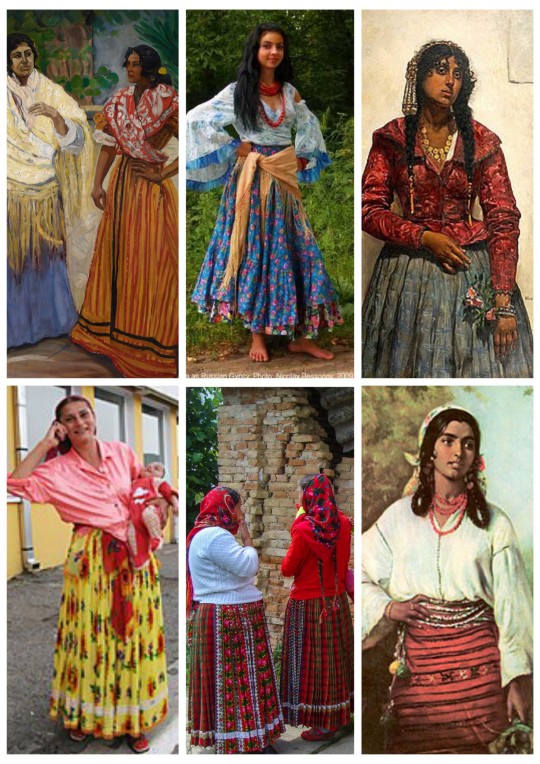
See the difference? Modesty is a huge aspect of Romani culture.
Culture & Society
Again, much of Romani culture is closed and has been kept alive through remaining closed. This is just what they (or scholars) have chosen to tell and what I have personally learned. It is important to remain respectful of what Romani people do and do not want to share. That said, not much is left of Indian influence in Romani culture save for the people who still celebrate Hindu holidays. However, what has survived is the concept of universal balance. Many believe that everything, or almost everything, fits into a natural place. For example, birds are supposed to fly right? It's chill to eat those if your faith allows it. But a penguin? That bitch doesn't fly, it's a freak of nature, so don't eat it. A penguin is out of balance and, therefore, bad luck. That's why Romani people traditionally don't eat hen eggs because girlie can't fly. Of course, other faiths like Muslim Roma, who have special recipes, eat hen eggs.
Like every race, every community and individual has a different faith. Most popular is Christianity and Catholicism and it has become the primary faith among Romani people. Other religions like Islam and Hinduism are also practiced. These faiths have their own set of rules that they follow alongside Romanipen, which is not written and passed down orally. Romani people even have their own patron saints: Ceferino Giménez Malla, The Virgin of Hope of Macarena who is specific to the Spanish Calé, and Kali Sara who is an Indian deity and protector of the Roma. For Christians and Catholics, they also worship the Virgin Mary and Jesus Christ.
Cleanliness is another big facet of Romani culture. Your genital area is considered impure and unclean. Because of this many Roma do not have pet cats or dogs because they lick their genitals. These rules are so strict that food must be entirely discarded should a strand of hair from these animals get into it as the whole meal is then contaminated. Additionally, tops and bottom are typically washed separately as to not mix pure and impure fabrics. This is especially true for AFAB menstruation, which is also seen as impure, as is childbirth. This is because of Romani code which is the most important part of Romanipen: pillars both honor and shame.
Like many societies, importance is placed on the men and subscribe to expected gender norms. In typical Romani home consists of a married couple, their unmarried children, at least one married son and his wife, and their children. Extended family and family in general are an integral part to Romani society so they will play active roles in a Romani child's life. It is possible to be expelled from your community, however, should you go against your community's rules or, for example, marry a gadjo. This is because, depending on the community, it would bring dishonor.
Every since the 16t century, Romani people have either made their livings or enjoyed their time through music and dance. Both still have Indian influences but have also added other elements depending of the region. For example, belly dancing is big among the Turkish Romani. Have you heard of flamenco music from Spain? Did you know that it came directly from the Romani Calé? Romani music has had a huge influence outside of the community, as it has inspired genres like bolero and jazz music.
Before I go onto how I want to see Romani culture integrated with Azusa content in the future, I want to touch up on adoption and interracial marriage. While interracial marriage is frowned upon in some communities, if a gadjo learns Romanipen and lives their life as if they are Romani, they are accepted as fully Romani. This also goes for adopted children. If they live by the rules and codes, dedicate themselves to the culture and society, then they are fully Romani.
Azusa Mukami, His Romani Identity, and What I Want To See More Of
While Diabolik Lovers does have it's problematic moments when referring to Azusa's past such as calling his community but the g-slur, it's super important to recognize how freaking awesome it is to have a Romani character who is largely not a racial caricature and not portrayed as less than simply for being Rom. He is a fully fleshed out and romancable character which is so cool.
It isn't explicitly stated whether Azusa was adopted by his community or is Rom by blood, but given the time period around the 1960's to 1980's (I recommend looking at @i-write-hurt-not-comfort's blog for more information on the Mukami's timeline) I would recommend steering FAR away from the idea of him being picked up since the baby-snatcher stereotype was and is still big. Plus, it's just so much more fun having a non-white Rom love interest. Let him be brown, y'all. Also, he's Romanian Romani, let me see him be Romanian Romani.
Speaking of which, know he's super pale but I want to see him be South Asian and anemic! It's so rare that Romani people are white and Azusa would look cute with tan or dark skin. I'd love to see more art where he has melanin. Brown and black people can be pale too due to things like anemia. Don't be afraid to make him look like a vampire that has not seen the sun in days who happens to be brown!
This man canonically loves spicy food! You know what race's food is super rich in spices and flavor? Romani food! I'd love fics where we get even a throw away line talking about him eating spicy stew or chile mole. Make him hold Ruki at knifepoint in the kitchen having him make some stuffed peppers.
Even small things like him not eating eggs or separating his tops and bottoms because that's what he learned to do as a child would be so damn nice to see. Tiny things that connect him to his race and heritage would be so cool to see in more content of him.
Final Thoughts
Romani people, each community and each individual, have such rich culture and history. They are incredibly interesting to learn about and have had so much influence over things we might not even thing about. They're not only in Europe. They're every where. South America, the US, Asia, every where. It's about time people started recognizing them outside of what governments and white supremacy teaches us and admire the resilience and beauty of the Romani people. Please do your own research and look for real Romani people to get more information from on TikTok, YouTube, hell even the damn bird app. I hope this helped whoever wanted to know more about the Romani people. Thank you sm for reading too, this was a long one.
#ren's essays#romani people#azusa mukami#diaboliklovers#Some of this information may not be fully accurate but I did my best#If you have anything to add please let me know! I love learning new things#This contained a lot of upsetting topics but it's history and that's expected#Thank you to that one person I had fun writing this
78 notes
·
View notes
Text
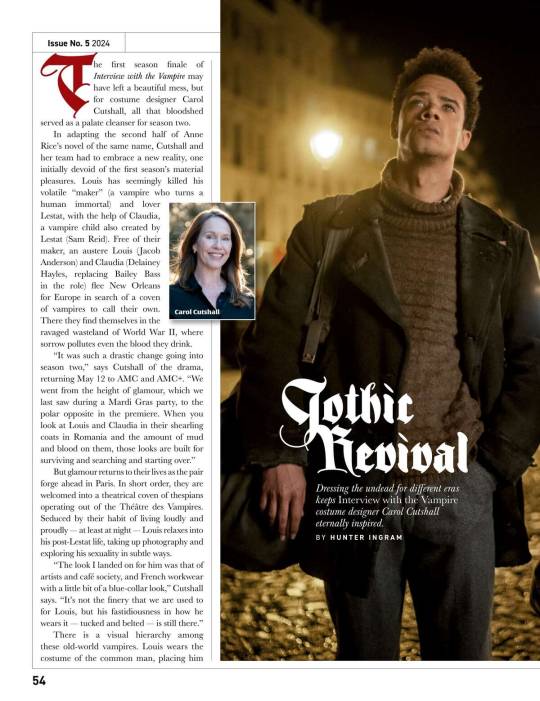
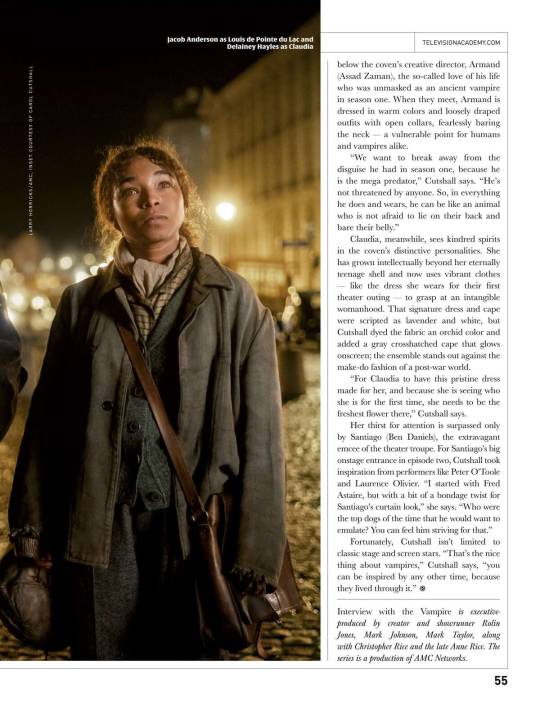
Carol Cutshall better get an Emmy this year, I ain't playin!
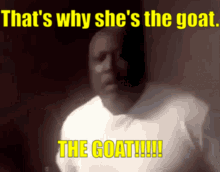
"Cutshall and her team had to embrace a new reality, one initially devoid of the first season’s material pleasures..... Free of their maker, an austere Louis and Claudia flee New Orleans for Europe in search of a coven of vampires to call their own. There they find themselves in the ravaged wasteland of World War II, where sorrow pollutes even the blood they drink."


"It was such a drastic change going into season two. We went from the height of glamour, which we last saw during a Mardi Gras party, to the polar opposite in the premiere. When you look at Louis and Claudia in their shearling coats in Romania and the amount of mud and blood on them, those looks are built for surviving and searching and starting over."
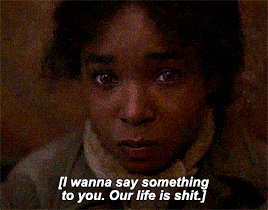
This what I meant when I talked about AMC intensifying the horror for show!Claudia vs book!Claudia. They're starting over, runaway slaves free at last from Massa Lestat's domestic terrorism; following the Drinking Gourd north to the promised land of milk & honey--but their exodus isn't some glorious adventure--it's Hell on Earth!
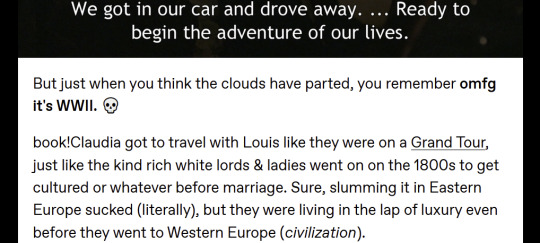
I adore the juxtaposition Carol makes between the obscene opulence of Mardi Gras NOLA vs the Grimm realities of war-torn Europe. Book!Lou&Claud traveled across Europe in a lavish carriage Claudia picked out, and had the luxury of taking their fancy coffins with them in it.


NGL I was hoping Carol would talk about these outfits in particular:
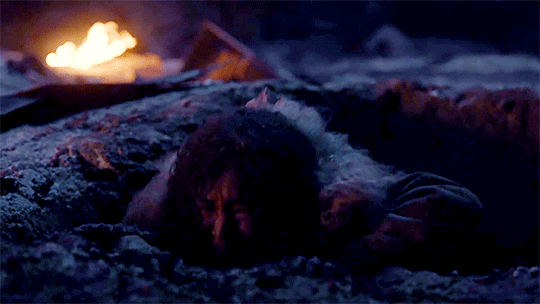

AMC's Lou & Claud look like they've been sleeping underground/in a battlefield, dressed in animal skins/furs--not the fancy furs PETA jumps folks for, but nasty Caveman Couture rags. And I can't help but think about the furs they wore in the film, looking rich AF, even as Lou complained about how sad he was. 🙄😒

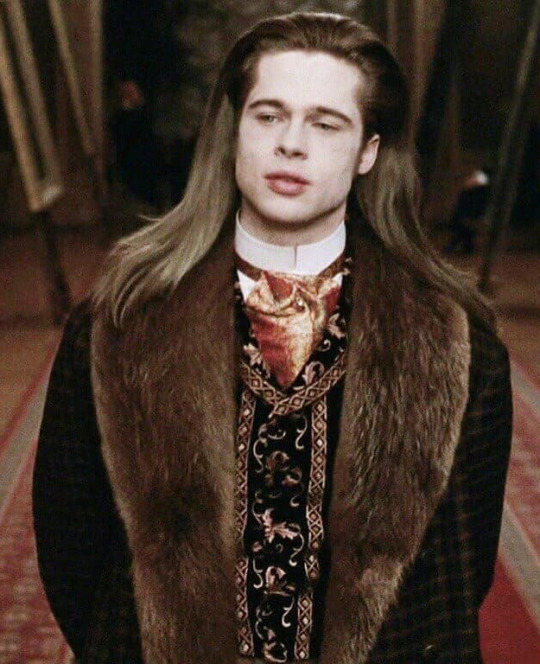

So I am SO IN LOVE with AMC sending Louis & Claudia to WWII Europe. They're in Ploiești/Romania in 1941--in the book they're in 1800s Varna/Germany. Romania was a major ally for the Nazis in WWII, and the LAST place Claud should be--let alone Louis (a gay Black African American man)--let alone because Romania was bombed TF up in the early 1940s.

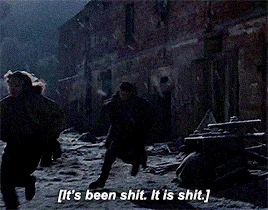
They're running slow AF like regular humans--no super vamp speed at their disposal to flee from the bombs--cuz they've been STARVING. They're eating the dead like a bunch of ghoulish necrophages (come through, Witcher 3 folklore!).

Like, in the film the big idea was that drinking dead blood could kill a vampire. But in TVL & Blood Communion we know that's not the case when Lestat drinks the corpses Armand gave him, and when Lestat gives the Vampire Court Rhoshamandes' corpse--it's not deadly, but it's not great, either. Drinking blood should be PEAK sensory pleasure; but this just shows what they've been reduced to.


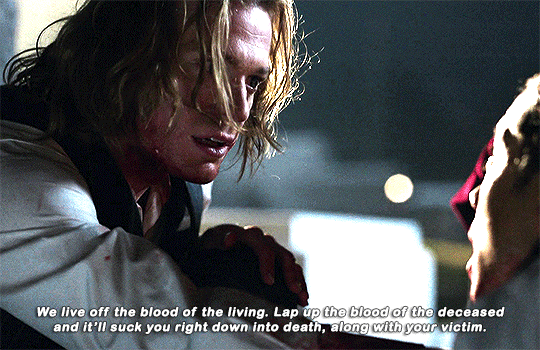
So to see Louis & Claudia tearing into pieces of the dead to suck up what's left is like cannibalism at its rawest, basest & most primitive--straight out of a dystopian zombie apocalypse. There's no transcendent power in the dead like what Maharet & Lestat described. Lou & Claud are scavengers in a battlefield, fighting for scraps just to survive and endure, but not really live.
And I feel so much worse for Claudia, cuz she LITERALLY didn't ask for this mess! Unlike Louis--and unlike book/film!Claudia--she was Born into Darkness w/out her awareness or consent. AMC puts this poor girl through HELL. The things she's seen & experienced made her "built for survival;" but she's also "built like a bird," and just as ignorant about vampires & the Old World as Louis--though they're both bookish intellectuals who THINK they're ready for Europe.


So they have no effing idea, cuz Lestat never told them WHY Europe was such bad news. They're blind and completely in the dark!

And then they FINALLY arrive in Paris--a breath of fresh air after the war.
But glamour returns to their lives as the pair forge ahead in Paris.... Seduced by their habit of living loudly and proudly — at least at night — Louis relaxes into his post-Lestat life, taking up photography and exploring his sexuality in subtle ways. “The look I landed on for him was that of artists and café society, and French workwear with a little bit of a blue-collar look,” Cutshall says. “It’s not the finery that we are used to for Louis, but his fastidiousness in how he wears it — tucked and belted — is still there.” There is a visual hierarchy among these old-world vampires. Louis wears the costume of the common man, placing him below the coven’s creative director, Armand, the so-called love of his life"
The "visual hierarchy" of Louis being "placed BELOW" the Old World vampires had me vibrating in my seat, especially wrt Armand, the biggest baddest boogeyman vs fledgling vampires in the books.
"We want to break away from the disguise he had in season one, because he is the mega predator,” Cutshall says. “He's not threatened by anyone. So, in everything he does and wears, he can be like an animal who is not afraid to lie on their back and bare their belly."
Which is precisely what I said about Lestat in his Mardi Gras dress & his Matador pajamas. Cuz Lou & Claud are constantly put on the exact same level--at the BOTTOM of the food chain & the gendered/social hierarchies of vampire covens in both NOLA & Europe.

But what's interesting's that AMC diversified the Theatre--there's Black & Asian vampires, not the all-white coven from the books.
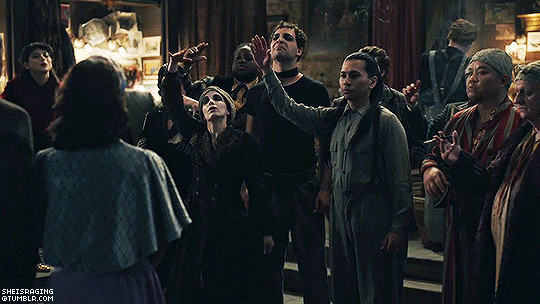
The Theatre has truly become a microcosm of the entire world, highlighting just how sheltered Lou & Claud were in the New World. The history of America is very black and white--or rather: white versus black. After the Native Americans were wiped out, American racism molded & shaped centuries of slavery & oppression specifically designed to keep Black people at the bottom of barrel, even when they were "freed/emancipated." But in the Old World, power & conquest was continental--Africa & Asia & Europe were ALL major superpowers at one time or another, kicking each other's arses. Race & racism still plays a huge part in European imperialism, OF COURSE, but WWII showed how white folk are just as prone to killing & oppressing each other, let alone anyone else. 😂 Louis & Claudia's problems w/ Lestat are radically different from their problems w/ Armand (now a brown Asian, as Russia & Ukraine are also globalized; dispelling the myth about Russians only ever being white people).
But Santiago's an altogether different beast--but eerily familiar.
"Her thirst for attention is surpassed only by Santiago, the extravagant emcee of the theater troupe. For Santiago’s big onstage entrance in episode two, Cutshall took inspiration from performers like Peter O’Toole and Laurence Olivier. “I started with Fred Astaire, but with a bit of a bondage twist for Santiago’s curtain look,” she says. “Who were the top dogs of the time that he would want to emulate? You can feel him striving for that."


What is fundamentally wrong with Santiago (and Lestat) is that he's a HUGE showboat, desperate for attention & validity, specifically from LOUIS, a vampire older than Santiago, attractive & new & interesting, who's approval he actually wanted & expected. But Louis's too mature/smart for Santiago, and immediately clocked him as a clown and a BUFFOON.

AMC dyed Santiago's hair blonde on purpose, ISTG, cuz the parallels w/ Lestat are hilarious. Armand's the coven master & creative director, but Santiago's the emcee & "show pony," just like Lelio!Lestat was back in the day. Les' pony on meth meme is SO apt!

And just like Lestat pulled the rug under Armand at Les Innocents, taking on a leadership role for the Children of Satan and ushering in their new era as vampires who'd join society via the Theatre, Santiago usurps Armand's position as the ringleader against Claudia & Louis. Even though Armand wanted all that to happen, he's more passive than Les & Santiago, far more active & dominant despite being significantly weaker & younger in the Blood than Armand. Wolf Killer Lestat and "top dog" Santiago are cut from the same cloth, down to the pinstripes--which Carol already said were supposed to symbolize cage/jail bars--"back in your cage, sweetheart."

CAROL! I desire you CARNALLY! ❤️
#interview with the vampire#justice for claudia#louis de pointe du lac#the vampire armand#male fashion#fashion statement#fashion history#read a dang history book#mind blown#must see tv#the hype is real#iwtv tvc metas
35 notes
·
View notes
Text

Bombardement par l'USAAF de la raffinerie de pétrole de Ploiesti – Opération Tidal Wave – Ploiesti – Roumanie – 1er août 1943
L'Opération Tidal Wave est un bombardement stratégique de grande envergure effectué le 1er août 1943 depuis Benghazi en Libye par l’USAAF contre le complexe pétrolier roumain de Ploiești qui était la principale source de carburant des forces allemandes.
Au premier plan se trouve le B-24D Li'l Jughaid de la Ninth Air Force, 98th Bombardment Group, 415th Bombardment Squadron (pilote Lyle Spencer, copilote Harry J. Baker, bombardier Boyden Supiani). La photographie a été prise depuis l'avion de tête du 98th piloté par le colonel John R. Kane. Les B-24 Daisy Mae et Black Magic suivent en formation derrière Li’l Jughaid.
#WWII#bombardements stratégiques#strategic bombing#opération Tidal Wave#operation Tidal Wave#Armée de l'air américaine#united states army air forces#ploiesti#roumanie#romania#01/08/1943#08/1943#1943
15 notes
·
View notes
Photo

Junkers Ju 87
The Junkers Ju 87 'Stuka' was a two-seater dive-bomber plane used by the German Air Force (Luftwaffe) in various theatres of the Second World War (1939-45). The Stuka, with its distinctive angled wings, excelled when combined with armoured divisions in Germany's blitzkrieg ('lightning war') tactics in the early years of the war, but its inferior speed and manoeuvrability compared to single-seat fighters meant that it was ultimately restricted to hitting static targets where the Luftwaffe enjoyed air superiority.
Design & Development
In 1934, the German aircraft company Junkers was commissioned by the Nazi regime to design a prototype dive bomber. The idea was that a dive-bomber aircraft would be capable of delivering bombs at a lower altitude and with more accuracy than traditional high-altitude bombers, which dropped their loads vertically. Three prototypes were produced with design adjustments made to ensure the wings of the aircraft could withstand the force of diving from altitude. The best Junkers design, which included a Junkers Jump 210A engine, impressed against competition from rival manufacturers Arado, Hamburger, and Heinkel. Both Junkers and Heinkel were commissioned to produce 10 aircraft each. Several Ju 87s, as they were now classified, were tested in real combat conditions in the Spanish Civil War (1936-9) where they were flown by Germany's Condor Legion.
The Junkers Ju 87 had two seats, one for the pilot and one immediately behind for the rear gunner/radio operator. The aircraft gained the nickname 'Stuka', short for Stürzkampfflugzeug, meaning 'dive-bomber' in German, although the Germans themselves nicknamed the plane 'Berta'. The Stuka's bomb load mechanism "swung the weapon clear of the fuselage and propeller arc before it was released" (Saunders, 30). This feature, combined with the aircraft's ability to dive at a steep 80-degree angle (helped by a special dive-braking system), meant that it could strike a target with a much higher degree of accuracy compared to other types of bombers. Hitting a moving or small target remained a challenge and so, given that there was a mere 1.5-second window in which to release the bomb load at the bottom of a dive, only the most skilled Stuka pilots could regularly hit the objective of their extensive training: a 10-metre radius circle. Nevertheless, dive-bombing "proved four times more accurate than normal horizontal bombing from altitude" (Dear, 115).
By 1938, the main Stuka production plant was the Weser plant at Berlin-Tempelhof. Further design tweaks were made to the fuselage and distinctive fixed landing gears with their 'trouser' covers. The angled, 'gull' wings of the Stuka also set it apart from other aircraft of the period. Over the course of several new production models, a much more powerful engine was installed, the most powerful being capable of an impressive 410 km/h (255 mph), although this was significantly less than the best Allied or Axis single-seat fighters of the period, which could fly well over 480 km/h (300 mph). As the Nazi regime geared up for a war of conquest in Europe, Junkers was required to step up Stuka production to 60 models a month. By the start of WWII, which began with Germany's invasion of Poland in September 1939, the Luftwaffe had 336 Stukas, a figure which soon increased to 557. These aircraft were divided into nine Luftwaffe Stukagruppen. The aircraft was also flown by the Italian air force and by the air forces of other Axis allies such as Bulgaria, Croatia, Hungary, and Romania.
Stuka Dive-bombers in Poland, 1939.
Bundesarchiv, Bild 183-1987-1210-502 / Hoffmann, Heinrich (CC BY-SA)
Continue reading...
22 notes
·
View notes